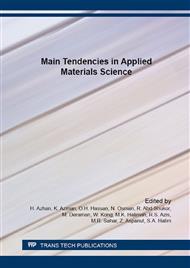p.3
p.13
p.20
p.27
p.37
p.45
p.52
p.58
Electrochemical Migration Behaviours of Low Silver Content Solder Alloy SAC 0307 on Printed Circuit Boards (PCBs) in NaCl Solution
Abstract:
Electrochemical migration (ECM) of solder joining can result in the growth of a metal deposit with dendrite structure from cathode to anode. In electronic device, this phenomenon potentially leads to the incompetence or failure of whole devices. In this paper, the ECM behaviour of printed circuit boards (PCBs) with SAC 0307, one of the low-cost lead-free solder alloys with less silver content, has been studied. The corrosion behaviour of SAC 0307 has been investigated by using sodium chloride solution in different concentrations which is between 0.01 M to 1.0 M as a medium. A Water Drop Test (WDT) was carried out and the time-to-failure of each sample has been recorded. After WDT test, the dendrite phase was identified using Variable Pressure Scanning Electron Microscope (VPSEM) with Energy Dispersive X-ray Spectroscopy (EDX) and X-ray Photoelectron Spectroscopy (XPS) to investigate its surface morphology and corrosion products. As results, it has been found that the corrosion susceptibility of SAC 0307 is greatly influenced by the concentration of the medium solution used. The voltage drop occurred was due to the dendrite grew at the cathode electrode on the PCBs and expanded to the anode electrode, indicating a significant effect of aggressive behaviour of the medium used. The rate of the dendrite growth was affected by the concentration of the medium used. The main element found in the dendrites on the SAC 0307 on PCBs was Tin as it is more mobile than Cu.
Info:
Periodical:
Pages:
3-12
Citation:
Online since:
March 2016
Keywords:
Price:
Сopyright:
© 2016 Trans Tech Publications Ltd. All Rights Reserved
Share:
Citation:


